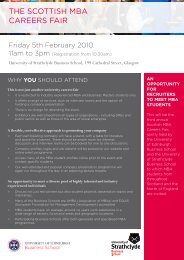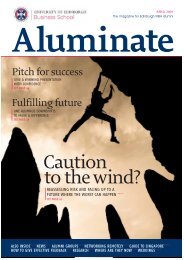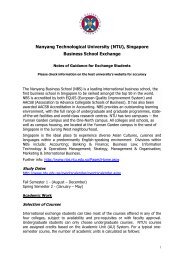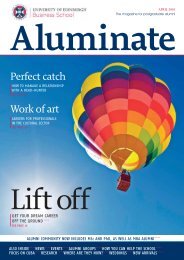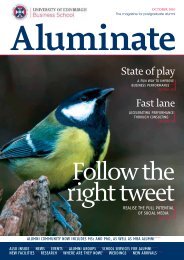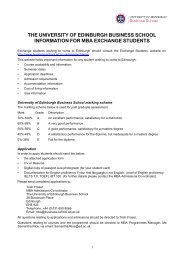killed Saab Automobile? - Business School - University of Edinburgh
killed Saab Automobile? - Business School - University of Edinburgh
killed Saab Automobile? - Business School - University of Edinburgh
Create successful ePaper yourself
Turn your PDF publications into a flip-book with our unique Google optimized e-Paper software.
this revival plan and did not propose an alternative. It thus appears somewhat naive <strong>of</strong> Spyker to<br />
assume that <strong>Saab</strong> could be developed and sustained on the basis <strong>of</strong> a plan that others had considered<br />
and rejected.<br />
Production restarted under Spyker, but the necessary sales failed to materialize and <strong>Saab</strong> quickly<br />
burned through its cash until it could not pay its suppliers or even its staff. By September 2011, shortterm<br />
liabilities mounted to 6.94bn SEK (€775m), compared to liquid assets <strong>of</strong> 40m SEK (€4.47m). We<br />
estimate debt to suppliers to have been €260m at this point lxxi .<br />
The launch <strong>of</strong> the new 9-5 in 2010 had <strong>of</strong>fered real hope for <strong>Saab</strong>, but there was a very small window<br />
during which sales had to take <strong>of</strong>f and economic levels <strong>of</strong> production be achieved before the cash ran<br />
out. The new 9-5’s poor sales were partially driven by the global financial crisis, and were not helped by<br />
uncertainty over the company’s future, which sparked concerns over residual values and future<br />
servicing and support <strong>of</strong> <strong>Saab</strong> cars.<br />
Muller's plans, such as they were, also contained a number <strong>of</strong> contradictions. lxxii On one hand, he<br />
declared his aim to be to restore the company’s fortunes by making '<strong>Saab</strong>s feel like <strong>Saab</strong>s again', yet<br />
all he had were three models developed by GM: the 9-3 (7 years old), the new 9-5, and the 9-4 (to be<br />
launched in 2011 and produced by GM in Mexico). It would have taken another full development cycle<br />
<strong>of</strong> 5-7 years to have 'all-new <strong>Saab</strong>s' to sell. Given this, was there any real chance <strong>of</strong> sales <strong>of</strong> current<br />
models picking up far enough and fast enough to fund future developments?<br />
Could China have saved <strong>Saab</strong>?<br />
With the recent growth in BRIC (Brazil, Russia, India, China) countries, many firms in these emerging<br />
countries have rapidly developed by exploiting growing local demand. It is not surprising that BRIC<br />
firms have developed global aspirations: Tata's US$ 2.3 billion acquisition in 2008 <strong>of</strong> Jaguar Land<br />
Rover is a good example, as is Shanghai Automotive Industry Corporations (SAIC)'s bid for Rover in<br />
2004.<br />
In the case <strong>of</strong> China, many Chinese firms are growing on the back <strong>of</strong> soaring domestic sales, but are<br />
eager to develop or acquire technology and brands. Buying stakes in ailing Western firms appears a<br />
quick and easy way to achieve this, but also brings several challenges for Chinese acquirers.<br />
Acquisitions, especially in the auto industry, are subject to China’s wider economic policy. Since the<br />
mid 1990s the China has been attempting to rationalize its fragmented automotive industry into a<br />
handful <strong>of</strong> champions and develop it as a ‘pillar industry’ <strong>of</strong> the economy. This has implications for<br />
Chinese auto firms wishing to engage with non-Chinese ones. China’s Central Government implements<br />
its automotive policy through the National Development and Reform Commission (NDRC), whose<br />
approval is required for any merger or takeover.<br />
The reasons for choosing the auto industry as a pillar industry are not difficult to see. An automobile is<br />
composed <strong>of</strong> more than 10,000 parts and components; the automotive industry is related to many other<br />
industries such as metallurgy, petroleum, chemistry, coal, light industry, electronics, and textiles, and it<br />
was reasoned that the development <strong>of</strong> an automotive industry would encourage Chinese enterprises in<br />
many sectors to specialise and better co-ordinate their efforts lxxiii .<br />
Initially China’s approach was to attract foreign vehicle manufacturers to establish a local production<br />
base in China, under the condition <strong>of</strong> forming a joint venture with a local state-owned enterprise (SoE).<br />
This policy saw a raid growth in production capacity, and local sourcing, but it did not produce the<br />
26





